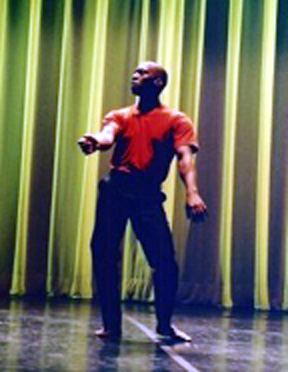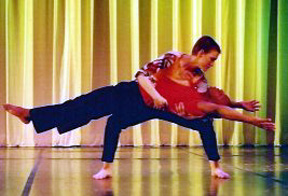Borris
Willis Moves
(Presented by Dance Place and The John F. Kennedy Center
for the Performing Arts)
Dance Place
Washington, DC
October 25-26, 2003
By Mary Tisa
Copyright © 2003
Mary Tisa
 Boris
Willis is an intensely physical artist. His work explores physical relationships,
his unique movement vocabulary pushes the limits of the human body, and
his duets are held together by a compelling physical attraction that is
especially effective when he dances with founding member Cynthia McLaughlin.
While Willis’s physical power is what distinguishes him as a performer,
his young company is not yet at his level. At times, underneath the flying
foot work and the daring contact improv freezes, a distracting lack of
cohesion mars the flow of the pieces and the connection between the dancers.
At present, the company's strength is that it brings a much needed voice
of immediacy to contemporary issues and matters of the human heart.
Boris
Willis is an intensely physical artist. His work explores physical relationships,
his unique movement vocabulary pushes the limits of the human body, and
his duets are held together by a compelling physical attraction that is
especially effective when he dances with founding member Cynthia McLaughlin.
While Willis’s physical power is what distinguishes him as a performer,
his young company is not yet at his level. At times, underneath the flying
foot work and the daring contact improv freezes, a distracting lack of
cohesion mars the flow of the pieces and the connection between the dancers.
At present, the company's strength is that it brings a much needed voice
of immediacy to contemporary issues and matters of the human heart.
This time out, the program consisted mainly of duets and trios, a safe choice for Willis at this stage of his company's development, perhaps, but I would have liked to see his whole company fill Dance Place's tiny space with his trademark movement. The four dancers, all women, have a certain angular, locked quality to their movement that keeps them from emulating Willis’s mesmerizing juxtaposition of weightless release and tight athletic power. These young dancers also lack the haunting emotionality that is key to providing an internal context to the difficult issues Willis explores in his work. However, they brought a precise execution to Willis’s faster and quirkier choreography, exhibited in the lighthearted and compositionally complex Soy Chai Latte.
Half of the pieces on the program explored different facets of the effect relationships and social conventions have on the human heart. In Aliens, choreographed in 2001 and the evening's oldest work, Willis and Emily Bodoh recreate a dance club atmosphere as they intimately move together amidst a backdrop of flashing neon lights and almost painfully blaring techno music by Autchure. The nonverbal connection between the dancers, two strangers, is exemplified by the searing stare the two share as Bodoh confidently crosses the stage, passing Willis, locked center stage in a haze of neon light and racing sound. The ending is especially memorable: Bodoh takes Willis’s shirt, leaves, and draws back to Willis, who has collapsed onto the floor and lies, illuminated by white light that exposes his emotionally naked and vulnerable state.
Enter Race, a new work by Willis that was commissioned by The John F. Kennedy Center for the Performing Arts and will be performed at the Millennium Stage in February 2004, was the centerpiece of the program. The dance explores the limitations of race as a social construct and its effect on interracial relationships. Enter Race uses multi-media to make its points, sometimes more successfully than others. During one moment, for example, Willis crouches, alone onstage, as images from his life are projected onto the wall behind him. Here, choreography and image work together to show Willis caught in a sea of memories and conflicting pressures. Another moment was more ambiguous: Willis dances center stage before a video in which he trails a hand along a wire fence. I wondered about the purpose of the image, as there seemed no emotional connection between it and the movement, such as Willis echoing the video in his gesture.
 Willis
and McLaughlin are a powerful couple. Their duet is full of emotional
and physical repetitions that echo the turbulent emotional cycle evident
in interracial relationships. Willis and McLaughlin tentatively come together
in an embrace; their intimate movement builds to convey desperation and
passion, and the embrace slowly dissolves as the dancers part with hesitation
and longing. The dancers stand facing each other centerstage and begin
an intricate handholding phrase where their fingers intertwine and unfold
in a myriad of shapes. Later the two individually deconstruct the phrase,
conveying a broken half of a whole: Willis raises up his now bare hand
in a twisted shape and plunges it into heart like a dagger. The pedestrian
inspired movements and the cyclical compositional pattern make the subtle
love Enter Race examines powerful and real.
Willis
and McLaughlin are a powerful couple. Their duet is full of emotional
and physical repetitions that echo the turbulent emotional cycle evident
in interracial relationships. Willis and McLaughlin tentatively come together
in an embrace; their intimate movement builds to convey desperation and
passion, and the embrace slowly dissolves as the dancers part with hesitation
and longing. The dancers stand facing each other centerstage and begin
an intricate handholding phrase where their fingers intertwine and unfold
in a myriad of shapes. Later the two individually deconstruct the phrase,
conveying a broken half of a whole: Willis raises up his now bare hand
in a twisted shape and plunges it into heart like a dagger. The pedestrian
inspired movements and the cyclical compositional pattern make the subtle
love Enter Race examines powerful and real.
For me, the high point of the show was Willis’s solo, I’m Just Saying. As a solo artist, Willis commands the stage by his mesmerizing mastery of movement and his ability to express emotion through movement. Although his face remains impassively neutral, the weightless arc and release of his body carries with it explicit emotion and intensity. I’m Just Saying is a visual sentence fragment of failed words. Willis writes something mid-air and then meticulously erases it. He executes a gestural sequence which he then deconstructs and rub away. His lips urgently form words, yet he makes no sound. The overall effect was evocative and powerful, like a bad dream from which one cannot escape.
Both photos are from Willis's Aliens: top, Borris Willis; second, Willis with Cynthia McLaughlin. Photos: Todd Clark.
Originally
published:
www.danceviewtimes.com
Volume 1, Number 6
November 2, 2003
©2003
Mary
Tisa
|
|